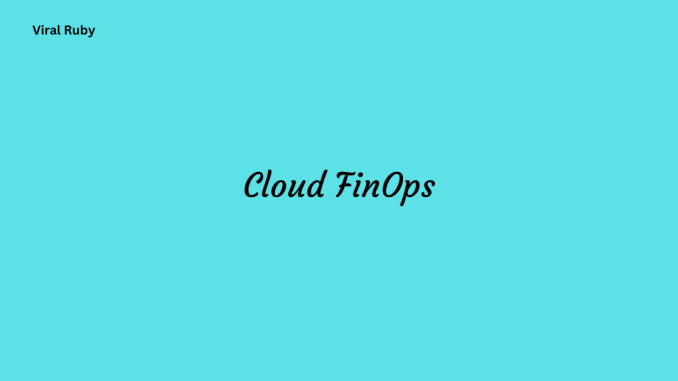
Cloud FinOps Principles Strategies Tools and Challenges
Introduction to Cloud FinOps: Optimizing Cloud Costs
Cloud FinOps, short for Financial Operations, is a discipline that focuses on optimizing cloud costs and maximizing the value organizations derive from their cloud investments. As businesses increasingly embrace the cloud for their computing needs, managing and controlling cloud costs has become a critical aspect of efficient operations.
In traditional on-premises environments, capital expenses were predictable and relatively stable. However, cloud computing introduces a pay-as-you-go model, where costs can fluctuate based on resource usage, storage, data transfer, and other factors. This dynamic cost structure necessitates a new approach to financial management in the cloud.
Cloud FinOps combines financial management practices, operational processes, and cloud technology to help organizations understand, control, and optimize their cloud spending. It brings together finance, operations, and technology teams to collaborate on cost visibility, accountability, and optimization.
Key Elements of Cloud FinOps:
Cost Visibility: Cloud FinOps emphasizes the need for comprehensive cost visibility across an organization’s cloud infrastructure. It involves tracking and analyzing cloud expenditures at a granular level to identify cost drivers, usage patterns, and potential areas for optimization.
Cost Allocation: Cloud FinOps provides mechanisms to allocate cloud costs to different departments, projects, or teams. It enables organizations to understand how cloud resources are being utilized and align costs with business priorities. Effective cost allocation promotes transparency and accountability, fostering a culture of cost-consciousness.
Cost Optimization: Cloud FinOps focuses on optimizing cloud costs without compromising performance or functionality. It involves implementing strategies such as rightsizing instances, leveraging reserved instances or savings plans, optimizing storage, and automating resource provisioning and deprovisioning to eliminate waste and optimize spending.
Governance and Accountability: Cloud FinOps establishes governance frameworks and cost management policies to ensure financial discipline in the cloud. It encourages collaboration between finance, operations, and IT teams to set budgets, define spending limits, and monitor adherence to cost targets. Clear accountability structures drive responsible cloud usage and cost control.
Key Principles and Strategies of Cloud FinOps
Cloud FinOps, short for Cloud Financial Operations, is a discipline that focuses on managing and optimizing the costs of cloud computing resources. It combines financial management, operations, and technology to ensure cost efficiency and effective resource allocation in the cloud. Here are some key principles and strategies of Cloud FinOps:
Cost Transparency: Cloud FinOps emphasizes the importance of having visibility into cloud costs and usage. This involves implementing cost tracking mechanisms and tools to monitor resource consumption, identify cost drivers, and allocate costs to different teams or projects accurately.
Cost Optimization: The primary goal of Cloud FinOps is to optimize cloud costs without sacrificing performance or functionality. This includes identifying cost-saving opportunities, such as rightsizing instances, utilizing reserved instances, leveraging spot instances, and implementing cost-effective storage solutions.
Collaborative Approach: Cloud FinOps encourages collaboration and communication between finance, operations, and development teams. It involves creating cross-functional teams or establishing forums where stakeholders can discuss cost-related decisions, share best practices, and align cloud spending with business objectives.
Automated Cost Management: Automation plays a crucial role in Cloud FinOps. By implementing automated processes and tools, organizations can collect, analyze, and act upon cost and usage data more efficiently. Automation can also enable dynamic scaling and the automation of cost optimization techniques.
Financial Accountability: Cloud FinOps promotes financial accountability by assigning cost responsibilities to different teams or business units. This allows teams to have ownership over their cloud costs and encourages them to make informed decisions to optimize spending based on their specific needs and priorities.
Continuous Improvement: Cloud FinOps is an iterative and continuous improvement process. It involves regularly reviewing and refining cost management practices, optimizing cost allocation, and exploring new strategies to drive cost efficiency and control in the cloud.
Cost Governance: Effective cost governance is essential in Cloud FinOps. It involves establishing policies, guidelines, and guardrails to govern cloud spending, enforce compliance with budget limits, and prevent cost overruns. This can include implementing cost allocation tags, setting budget alerts, and establishing approval processes for high-cost resources or projects.
Education and Training: Cloud FinOps recognizes the importance of educating teams about cloud costs, optimization techniques, and the impact of their decisions on the organization’s financial health. Providing training and resources to teams empowers them to make cost-conscious decisions and fosters a culture of cost optimization.
Cloud Vendor Management: Managing relationships with cloud service providers is a critical aspect of Cloud FinOps. Organizations need to monitor vendor pricing models, negotiate contracts, and stay informed about new offerings or pricing changes that may impact costs. Vendor management ensures organizations get the best value for their cloud investments.
Tools and Technologies for Cloud Cost Management
Managing and optimizing cloud costs requires the use of various tools and technologies that provide visibility, analysis, and control over cloud spending. These tools help organizations monitor usage, identify cost drivers, track expenses, and implement cost optimization strategies. Here are some commonly used tools and technologies for cloud cost management:
Cloud Service Provider (CSP) Cost Management Tools: Major cloud providers such as Amazon Web Services (AWS), Microsoft Azure, and Google Cloud Platform (GCP) offer their own native cost management tools. These tools provide dashboards, reports, and cost analytics to monitor spending, track usage patterns, and optimize costs within their respective cloud environments.
Cloud Cost Management Platforms: Several third-party platforms specialize in cloud cost management and provide centralized management across multiple cloud providers. These platforms integrate with different CSPs, consolidate cost data, and offer advanced analytics, budgeting features, and cost optimization recommendations. Examples include CloudHealth by VMware, Cloudability, and CloudCheckr.
Infrastructure-as-Code (IaC) Tools: Infrastructure-as-Code tools, such as AWS CloudFormation, Azure Resource Manager, and Terraform, enable organizations to define and provision cloud resources programmatically. These tools allow for the automated deployment and management of infrastructure, ensuring optimal resource allocation and cost efficiency.
Cloud Resource Tagging: Resource tagging is a practice that involves assigning metadata to cloud resources such as instances, storage volumes, and databases. It enables organizations to categorize resources based on business units, projects, or cost centers. Cloud cost management tools leverage these tags to provide granular cost allocation and better visibility into spending patterns.
Cost Analytics and Optimization Tools: Advanced analytics tools help organizations analyze cost data and identify opportunities for optimization. These tools provide insights into cost trends, resource utilization, and optimization recommendations. Examples include Apptio, Cloudability, and Densify.
Reservation and Savings Plan Tools: Cloud providers offer reservation and savings plans that provide discounted pricing for committed usage. Tools such as AWS Savings Plans Recommendations and Azure Cost Management help organizations analyze their usage patterns and recommend appropriate reservation or savings plan purchases to optimize costs.
Serverless Frameworks: Serverless architectures, such as AWS Lambda and Azure Functions, offer cost-efficient compute options by charging only for the actual usage. Leveraging serverless frameworks can help organizations minimize idle resource costs and optimize spending on compute resources.
Cloud Cost APIs and SDKs: Cloud providers offer APIs and software development kits (SDKs) that allow organizations to programmatically access and manage cost-related data. These APIs enable custom integrations with in-house systems, reporting tools, and other cost management platforms.
DevOps and Automation Tools: Implementing DevOps practices and automation tools like Jenkins, Ansible, and Kubernetes can help organizations optimize cloud costs by automating resource provisioning, scaling, and deprovisioning. Automation ensures that resources are utilized efficiently, reducing unnecessary costs.
Containerization and Orchestration Tools: Containerization technologies like Docker and container orchestration platforms like Kubernetes can help optimize cloud costs by allowing efficient resource utilization, scaling, and management of containerized applications.
Implementing a Cloud FinOps Framework in Your Organization
Implementing a Cloud FinOps framework in your organization requires careful planning and execution. Here’s a step-by-step guide to help you get started:
Define Objectives: Clearly define your organization’s objectives for implementing Cloud FinOps. This could include cost optimization, budget control, increased financial transparency, or better resource allocation. Align these objectives with your overall business goals.
Build a Cross-Functional Team: Form a cross-functional team consisting of members from finance, operations, IT, and development departments. This team will be responsible for driving the Cloud FinOps initiative, collaborating on cost optimization efforts, and ensuring effective communication across departments.
Establish a Cost Tracking System: Implement a robust cost tracking system to monitor and analyze cloud usage and costs. This may involve using cost management tools provided by your cloud service provider or third-party solutions. Ensure that the system captures granular usage data and supports tagging for cost allocation.
Define Cost Allocation Methodology: Determine how costs will be allocated to different teams or projects. Establish a cost allocation methodology that aligns with your organization’s structure and business needs. This may involve using tags, account hierarchy, or custom allocation rules.
Set Budgets and Targets: Define budgets and cost targets for different teams or projects. Ensure that these budgets are realistic, and they align with the organization’s financial goals. Regularly review and adjust budgets as needed based on business priorities and market conditions.
Implement Cost Optimization Strategies: Work with your teams to identify and implement cost optimization strategies. This may include rightsizing instances, utilizing reserved instances or spot instances, leveraging serverless architectures, implementing auto-scaling, optimizing storage, and exploring cost-effective pricing models.
Foster a Cost-Conscious Culture: Educate and train your teams about Cloud FinOps principles and best practices. Promote a culture of cost-consciousness by encouraging teams to take ownership of their cloud costs and make informed decisions to optimize spending. Provide regular feedback and recognition for cost-saving efforts.
Monitor and Analyze Cost Data: Continuously monitor and analyze cost data to identify cost trends, anomalies, and areas for optimization. Leverage cost management tools and dashboards to gain insights into usage patterns, cost drivers, and opportunities for improvement. Regularly share cost reports and insights with stakeholders.
Implement Cost Governance: Establish cost governance policies and processes to enforce budget control and cost management. This may involve setting up approval workflows for high-cost resources or projects, implementing cost thresholds or alerts, and regularly reviewing and optimizing cost governance mechanisms.
Review and Iterate: Regularly review and evaluate the effectiveness of your Cloud FinOps framework. Solicit feedback from teams, identify areas for improvement, and iterate on your processes and strategies. Keep up with evolving cloud technologies, pricing models, and best practices to ensure ongoing optimization.

Leave a Reply